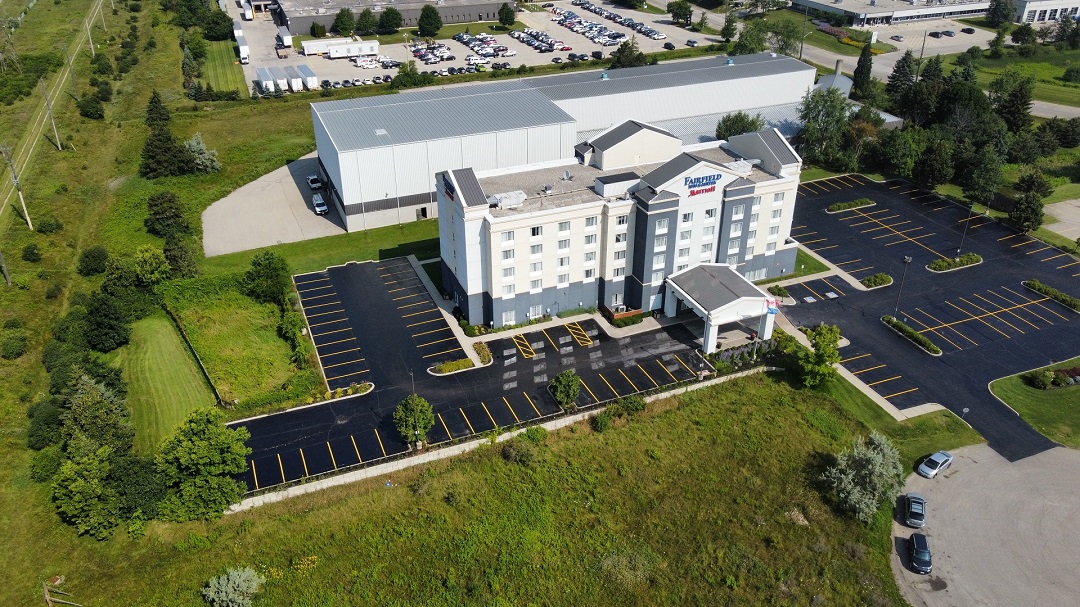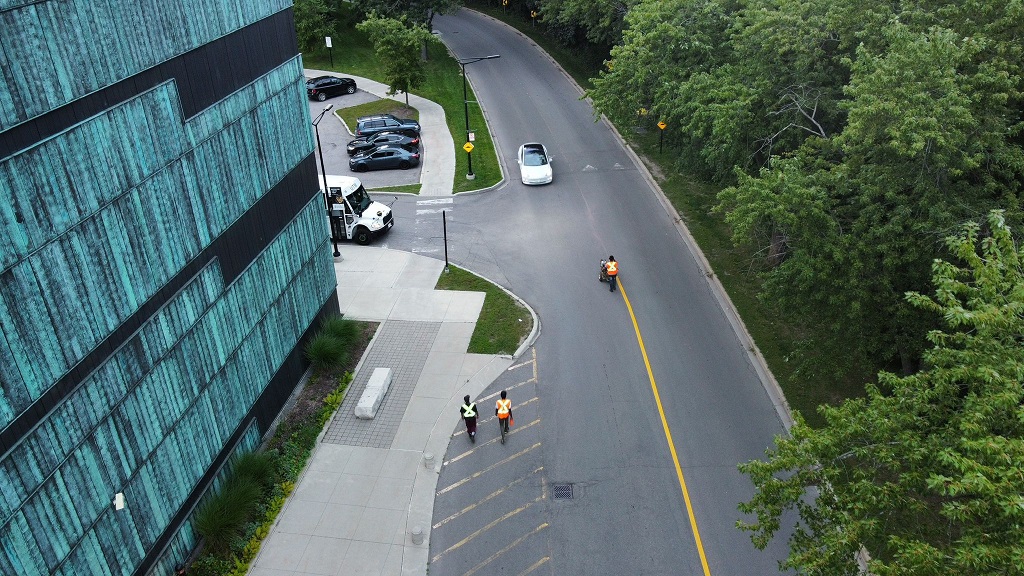Introduction
When it comes to maintaining the longevity and safety of paved surfaces, addressing pavement cracks is non-negotiable. Often overlooked and underestimated, these fissures, if left unattended, can evolve from minor annoyances into major problems, leading to a series of structural challenges and safety hazards. However, with the right approach to crack repair, the integrity of your pavement can be preserved, extending its lifespan and maintaining its aesthetics.
In this comprehensive guide, “Crack Routing 101:
The Essential Guide to Effective Crack Sealing and Repair,” we delve deep into the pivotal process of crack routing – a preparatory step that is crucial yet often misunderstood in the realm of pavement maintenance. Beyond merely filling in the cracks, this guide will illuminate the science and strategy behind effective crack repair, highlighting why routing is a step you cannot afford to skip if you’re aiming for a durable, long-lasting solution.
The journey through the intricacies of crack repair begins with an understanding of the purpose and benefits of crack routing, setting the stage for an in-depth exploration of how this process, when combined with proper sealing techniques, can fortify your pavement against the elements and the test of time. Whether you’re a property manager, a maintenance professional, or simply a homeowner seeking to preserve your investment, this guide promises to equip you with the knowledge you need to make informed decisions about maintaining your pavement’s integrity.
Stay tuned as we navigate the twists and turns of crack routing, sealing, and repair, ensuring that your pavement is not just repaired, but restored and revitalized.
Understanding Crack Repair
Crack repair is not just a facet of pavement maintenance; it’s a critical intervention that combats the progressive deterioration of paved surfaces. This section demystifies the concept of crack repair, laying the groundwork for a deeper appreciation of the intricacies involved in this essential maintenance task.
The Significance of Crack Repair in Pavement Maintenance
Pavements, be it driveways, parking lots, or walkways, are subjected to a barrage of stresses daily. Environmental factors, thermal fluctuations, and the relentless burden of traffic contribute to the formation and propagation of cracks. Left unaddressed, these cracks evolve, allowing moisture, debris, and other harmful elements to penetrate the surface, compromising the structural integrity of the pavement and shortening its lifespan.
Crack repair, therefore, is not merely a cosmetic fix but a vital intervention that shields the pavement from further damage. It involves a series of steps aimed at not just sealing the cracks but ensuring that the repair stands the test of time and the elements.
Addressing Common Pavement Issues Through Crack Repair
Moisture Intrusion Prevention: Water is the nemesis of pavement. It seeps through cracks, erodes the base, and in colder climates, freezes and expands, exacerbating the cracks. Effective crack repair seals these openings, denying water entry and protecting the pavement’s foundational layers.
Pavement Degradation Prevention: Unrepaired cracks lead to potholes and an overall degradation of the pavement surface. Timely crack repair interventions can halt this degradation, preserving the pavement’s functionality and appearance.
Safety and Liability: Cracks are not just unsightly; they’re hazards. Pedestrians can trip, vehicles can suffer damage, and the property owner can face liability issues. Repairing cracks promptly eliminates these hazards, ensuring the safety of all who traverse the pavement.
Cost-Efficiency: Investing in crack repair is cost-effective in the long run. It prolongs the pavement’s lifespan, deferring the hefty expenses associated with full-scale pavement rehabilitation or replacement.
In the next sections, we will delve into the specifics of crack routing, a preliminary yet pivotal step in the crack repair process, setting the stage for a successful, enduring repair. Understanding the role of crack routing is fundamental to appreciating its value in the broader context of pavement maintenance and repair.
What is Crack Routing?
Crack routing is a fundamental, yet often overlooked, step in the comprehensive approach to crack repair. This section sheds light on what crack routing entails and underscores its pivotal role in the crack repair process.
Defining Crack Routing
Crack routing is the process of enlarging a pavement crack, typically in width and depth, to create a clean, uniform, and contoured space for the application of crack sealant. This preparatory step is performed using a specialized machine known as a crack router, which is designed to carve out a reservoir in the existing crack. The primary objective of crack routing is to establish an optimal foundation for the sealant, ensuring it adheres properly and performs effectively.
Purpose of Crack Routing in Crack Repair
Clean and Dry Reservoir Creation: Crack routing removes debris and moisture from the crack, providing a clean, dry reservoir for the sealant. This cleanliness is crucial for the adhesion of the sealant to the pavement walls.
Enhanced Sealant Adhesion: A well-routed crack provides a greater surface area for the sealant to adhere to, compared to a non-routed crack. This strong bond is vital for the longevity and effectiveness of the repair.
Controlled Sealant Depth: Routing allows for precise control over the depth of the sealant reservoir. This is important for ensuring the sealant’s performance, as too much sealant can lead to a slippery surface, while too little can lead to inadequate crack filling.
Thermal Crack Accommodation: Pavements expand and contract with temperature changes. A properly routed crack provides a reservoir that allows the sealant to expand and contract, preventing it from tearing away from the crack walls.
Prevention of Crack Overbanding: Overbanding is when excess sealant is left on the pavement surface, creating a slippery and unsightly condition. Routing helps in applying the sealant precisely within the crack, minimizing overbanding and ensuring a clean, professional finish.
Crack routing is not just a preparatory step; it’s an enhancement to the crack repair process, ensuring that the applied sealant performs at its best. The next section will delve into the benefits of crack routing in detail, highlighting how this step elevates the quality and durability of crack repair.
The Benefits of Crack Routing
Having understood what crack routing is and its purpose in the crack repair process, it’s crucial to highlight the specific advantages that this preparatory step brings to the table. Each benefit plays a significant role in enhancing the overall effectiveness and longevity of the crack repair.
Enhanced Sealant Performance
Optimal Sealant-to-Crack Wall Contact: By creating a uniform and contoured reservoir, crack routing ensures maximum contact between the sealant and the crack walls. This optimal contact is key to ensuring the sealant adheres properly and performs its function effectively.
Increased Sealant Flexibility: The space created by routing allows the sealant to accommodate pavement movement due to temperature changes or traffic loads. This flexibility prevents the sealant from tearing away from the crack walls, maintaining the integrity of the repair.
Extended Pavement Life
Water Intrusion Prevention: One of the primary threats to pavement is water intrusion, leading to base erosion and freeze-thaw damage. A well-routed and sealed crack keeps water out, protecting the pavement’s structural integrity and prolonging its life.
Reduced Risk of Crack Expansion: By properly sealing routed cracks, the risk of the cracks expanding further is significantly reduced. This prevention of crack expansion safeguards the pavement against more extensive and costly damage.
Improved Safety and Aesthetics
Minimized Trip Hazards: Properly filled and sealed cracks create a smooth surface, reducing the risk of trips and falls for pedestrians. This is especially crucial in areas with high foot traffic.
Enhanced Surface Appearance: A well-executed crack repair, starting with precise routing, results in a cleaner, more professional finish. This attention to detail improves the overall appearance of the pavement, contributing to the property’s curb appeal.
Cost-Effective Maintenance
Prevention of Costly Repairs: By addressing cracks promptly and effectively, routing and sealing prevent minor issues from escalating into major repairs, saving money in the long run.
Longevity of Repair: The thorough preparation provided by routing ensures that the repair lasts longer, reducing the frequency and hence the cost of maintenance activities.
Crack routing, when done correctly, sets the stage for a crack repair that is not just a temporary fix but a long-term solution. The process ensures that the sealant performs to its full potential, extending the life of the pavement and offering a safe, aesthetically pleasing surface. In the next section, we will explore the crack sealing process, highlighting how it complements the routing process to provide an enduring solution to pavement cracks.
The Crack Sealing Process
After understanding the crucial role of crack routing in preparing the pavement for repair, it’s essential to explore the subsequent step: the crack sealing process. This section details the procedure that follows routing, emphasizing the importance of technique and quality materials in achieving a successful, long-lasting repair.
Preparation and Application: A Step-by-Step Guide
Cleaning the Crack: Post-routing, it’s imperative to ensure that the crack is free from dust, debris, and moisture. This is often achieved using compressed air or a hot air lance, which not only cleans but also dries the crack, ensuring optimal conditions for sealant adhesion.
Choosing the Right Sealant: The selection of sealant depends on various factors, including the pavement type, climate, and the nature of the cracks. Quality sealants are designed to accommodate the specific conditions of the pavement, offering the right balance of adhesion, flexibility, and durability.
Sealant Heating and Application: Most sealants need to be heated to a specific temperature to ensure proper flow and adhesion. Using professional-grade equipment, the heated sealant is applied into the routed crack, filling it from the bottom up to avoid air pockets and ensure a complete fill.
Finishing Touches: After the sealant application, it’s crucial to ensure a smooth, level finish. Tools like a squeegee or a sealing shoe are often used to press down the sealant, ensuring it’s perfectly level with the pavement surface and removing any excess.
The Importance of Technique and Timing
Expertise in Application: The effectiveness of crack sealing significantly depends on the precision of the application. Professional technicians, equipped with the right tools and expertise, can ensure that the sealant is applied correctly, maximizing the repair’s longevity.
Timing of Repairs: Weather conditions play a vital role in the success of crack sealing. Ideal conditions – typically dry and warm – are crucial for ensuring that the sealant adheres properly and cures correctly. Hence, timing the repair is as crucial as the repair process itself.
Post-Sealing Best Practices
Traffic Management: It’s important to keep traffic – both vehicular and pedestrian – off the sealed cracks until the sealant has adequately cured. This ensures that the sealant sets properly, without any pressure or disturbance.
Regular Monitoring and Maintenance: Even after a successful sealing, regular monitoring of the treated area is crucial. This proactive approach helps in identifying any issues early on and addressing them before they escalate.
The crack sealing process, when executed with precision and care, complements the initial routing step, ensuring that the pavement is not just repaired but restored. Combining the right technique, quality materials, and timely execution results in a crack repair that stands the test of time and use.
Best Practices for Crack Routing and Sealing
Achieving a durable and effective crack repair involves more than just following the basic steps of routing and sealing. It requires adherence to industry best practices and a keen attention to detail. This section outlines the key practices that should be followed to ensure the highest quality repair.
Equipment Selection and Maintenance
Choose the Right Router: Select a crack router that can adjust to different pavement contours and depths. Ensure that the machine is well-maintained to provide a clean, uniform reservoir.
Use Quality Sealant and Application Equipment: Invest in high-grade sealants that are appropriate for the pavement type and local climate. Similarly, use professional-grade application equipment to ensure even, consistent sealant application.
Operator Training and Expertise
Skilled Technicians: The success of crack routing and sealing significantly depends on the skill of the operator. Ensure that technicians are well-trained in using the equipment and are knowledgeable about the best practices in crack routing and sealing.
Attention to Detail: Technicians should pay close attention to every detail of the process, from ensuring the cleanliness of the crack to applying the sealant at the right temperature and consistency.
Timing and Environmental Conditions
Optimal Weather Conditions: Conduct crack sealing when the weather is dry and warm. Moisture and low temperatures can prevent the sealant from adhering properly and curing.
Avoid Rushed Repairs: Allow sufficient time for each step of the process, from routing to sealing to curing. Rushed jobs can lead to poor adhesion, ineffective sealing, and ultimately, a failed repair.
Post-Application Care
Proper Curing Time: Respect the curing time of the sealant. Keep traffic away from the sealed cracks until the sealant is fully cured to avoid damage and ensure the longevity of the repair.
Regular Inspection and Maintenance: Regularly inspect the sealed cracks and surrounding pavement. Early detection and repair of any issues can prevent minor problems from escalating into major concerns.
By adhering to these best practices, you can maximize the effectiveness and longevity of crack repairs, ensuring that the pavement remains safe and aesthetically pleasing for years to come. In the next section, we will highlight some common mistakes to avoid during the crack routing and sealing process, helping you steer clear of pitfalls and achieve the best results.
Conclusion
Crack routing and sealing are more than mere steps in pavement maintenance; they are investments in the longevity and safety of your property. This guide, “Crack Routing 101: The Essential Guide to Effective Crack Sealing and Repair,” has navigated you through the meticulous process of crack repair, from understanding its importance to exploring the detailed procedures of routing and sealing. The journey underscores the significance of precision, quality materials, and expert execution in safeguarding your pavement against the ravages of time and elements.
Maintaining pavement is not just about addressing the present; it’s about preserving the future. A well-executed crack repair not only enhances the immediate appearance and safety of your pavement but also wards off future damages, saving you from costly repairs down the line. It’s a testament to the adage that a stitch in time saves nine.
Are you ready to extend the life of your pavement and ensure its safety and aesthetics? Canadian Asphalt Maintenance is here to help. Our team of skilled professionals is equipped with the right tools and expertise to provide top-notch crack routing and sealing services. We understand the science and the art of pavement maintenance and are committed to delivering quality and durability that stand the test of time.
Don’t let cracks put a dent in your property’s value or safety. Visit our Crack Routing Service Page to learn more about our services or to schedule a consultation. Take the first step towards a safer, more beautiful pavement with Canadian Asphalt Maintenance.







